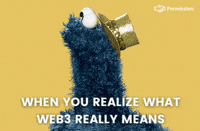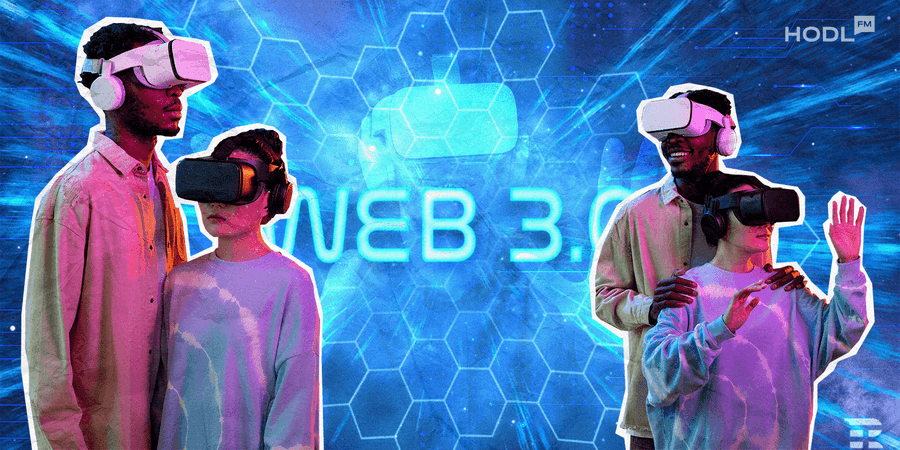The Web 2.0 boondoggle is slowly ebbing away, and the nail in the coffin is the rebranding of what we previously referred to as the semantic web into Web 3.0. Read on to learn about the ongoing Internet revolution. Here comes the no-barrier – limitless, trustless and permissionless – decentralization bringing openness and greater user utility. It’s the cog of the wheel of the fourth industrial revolution: steam engine, electricity, the microchip – and now blockchain and cryptocurrencies the fourth.
Read more: The Game Changer: How Web3 Games are Revolutionizing Ownership and Education

Definition of WEB 3.0
Also known as Web3, according to Harvard Business Review, Web 3.0 is the third iteration of the World Wide Web. Web 3.0 introduces a bottom-up design of the internet, known as decentralization, as it’s open to everyone and is built on the foundation of blockchain technologies. Web3 is built on a set of principles that envision a world without centralized companies so people can control their transactions recorded on blockchains and databases searchable by everyone.
Importance and evolution from WEB 1.0 and WEB 2.0
In the same way, we have different age ranges for various generations – Boomers, Generation X, and Millenials – and we have a variance in Web version activity. Web 1.0 (1990-200) was about fetching and reading information, Web 2.0 (2000-2010) has been about reading, writing, creating and interacting, and now Web 3.0 (2010 –onward) is about reading, writing, and creating things better online and owning.

Key Characteristics of WEB 3.0
This third iteration enables internet users to personalize their browsing experience as they connect with others, which is enabled by the development of new technologies like blockchain, Artificial Intelligence (AI), and Big Data. Using and applying data storage and analysis, particularly through Machine Learning (ML), the web will create a unique profile for every user to enhance their browsing experience.
Blockchain technology propagates web decentralization to change the lopsided relationship between users and Big Tech firms that control Web 2.0. The aim is to transfer the trust of the relationship to the distributed ledger technology and the trust it introduces. The technology consolidates reliability so content creators and users control their contributions and browsing preferences instead of leaving it to Big Tech companies. Web 3.0 introduces greater autonomy and reliability since data depends on the individual.
Technologies Powering WEB 3.0
Blockchain and Cryptocurrencies
Blockchain technology facilitates peer-to-peer (P2P) transactions, eliminating the need for clearance from central authorities. Also, a new wave of Web 3.0 cryptocurrencies is designed to make Web3’s vision a reality. Combining blockchain technology with smart contracts lets users control their data without engaging third parties.
Internet of Things (IoT)
Web 3.0 presents an archetype transforming how the Internet of Things businesses operate by promising complete ownership and decentralization. Web3 in IoT networks runs applications on decentralized networks that aim to give ownership to users. As a result, Web 2.0-based IoT companies will redefine their value propositions, strategies and business models.
Machine Learning and AI
Artificial Intelligence (AI) and Machine Learning (ML) use huge amounts of data and algorithms to mimic human thinking and offer predictions, respectively. Using the power of ML and AI, Web 3.0 discerns information just like humans do, and the scope of application is spreading to other areas, including finance. Netflix, Siri, Spotify and Cortana are examples of companies applying ML and AI.
Smart Contracts
Web 3.0 technologies run on smart contracts, the self-executing buyer-seller conditions translated into code and disseminated within the blockchain technology ecosystem. By eliminating the need for a central authority, legal systems or external enforcement, the irreversible and traceable smart contract system promotes trustworthy transactions that bring legal transparency to a new level.
Real-world Applications
Decentralized Finance (DeFi)
Decentralized Finance (DeFi), the novel idea that uses decentralized software to offer financial services, is among the most popular components of Web 3.0. The DeFi ecosystem comprises users who make financial transactions without the involvement of traditional financial gatekeepers like banks or governments.
Read more: Synthetic Assets: The Cyborgs of DeFi
Non-Fungible Tokens (NFTs)
Non-fungible tokens (NFTs), a form of crypto with unique features that cannot be interchanged, are another cornerstone of the Web 3.0 ecosystem. NFTs can be linked to physical or digital assets like a regular title deed and represent real estate property ownership. While governments may still need to recognize NFTs, the technology is evolving fast as large organizations join in, which could address existing regulatory issues in the future.
Web3 Social Networks
Web 3.0 is transforming the social media network sphere by emphasizing a creator-driven system that provides content ownership to the user and not centralized authorities. The result is Web 3.0-based social media applications moving away from the need to submit personal data to a central authority to enable anonymous access using private keys or a digital wallet address.
DApps (Decentralized Applications)
Centralized app Google Docs that facilitates collaboration and other conveniences stores your information in the cloud but controls and has access and can read it all in exchange. However, with Web 3.0-based decentralized applications (DApps), you enjoy all the benefits cloud services offer without submitting to a central authority. DApps, most of which are built on the Ethereum blockchain, conform to Web 3.0 characteristics by being secured through cryptography are public and open-sourced.
Read more: Coins and Tokens: What’s the Difference?
The Future of WEB 3.0
Web 3.0 promises to completely alter how we consume and share information online using AI capabilities and tailoring the user experience to their needs and preferences. Since information will be domiciled in users’ devices, it will enhance privacy and security, besides having freedom from censorship by governments or Big Tech Corporations. It will usher in a new phase of business growth.

As a system designed by users for users in the form of a creator-driven platform, Web 3.0 is set to become an integral part of the future of the Internet for the following reasons.
Less reliance on centralized systems: Web 3.0 will diversify the internet and deny hackers who thrive on the existence of centralized repositories the opportunity to thrive. Users will solely own their data and digital footprints via tokenized digital assets and verifiable data security.
More personalized interactions: Web 3.0 adoption levels will thrive as users prioritize individualized and customized browsing.
Eliminate intermediaries: By removing rent-seeking intermediaries, Web 3.0 will ensure businesses proffer value directly to their customers besides being able to address previously hard-to-control issues through mutual ownership.
Increased peer-to-peer connectivity: The development of new Internet inventions will promote the connection between organizations, machines and users so they can share more data while maintaining privacy and security.
Final Words
As we head toward an internet era where users will have total control over their privacy and data and choose whether Big Tech firms will use their data, we’re experiencing the power of blockchain.
More Info:
- Elon Musk’s Ex-Wife Made More Money From NFTs Than From Her Music Career
- Solana’s PlayGG Event: Flipping the Crypto Gaming Narrative
- Loyalty Gets a Makeover: Polygon’s Tokenized Rewards and Dynamic Connections
Web 3.0 is poised to fast-track the honest and transparent use of online data, whether for personalized searches, 3D graphics or cross-platform development and make user experience more interactive, immersive and beneficial.

Disclaimer: All materials on this site are for informational purposes only. None of the material should be interpreted as investment advice. Please note that despite the nature of much of the material created and hosted on this website, HODL FM is not a financial reference resource and the opinions of authors and other contributors are their own and should not be taken as financial advice. If you require advice of this sort, HODL FM strongly recommends contacting a qualified industry professional.




